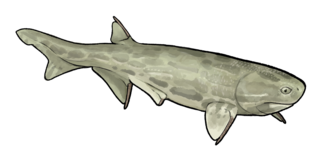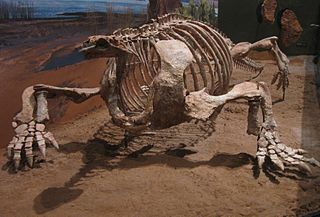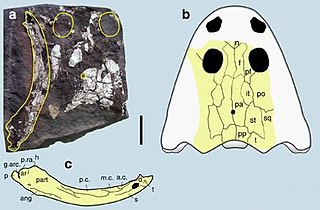
The Permian Basin is a large sedimentary basin in the southwestern part of the United States. It is the highest producing oil field in the United States, producing an average of 4.2 million barrels of crude oil per day in 2019. This sedimentary basin is located in western Texas and southeastern New Mexico.

Platyhystrix is an extinct temnospondyl amphibian with a distinctive sail along its back, similar to the unrelated synapsids, Dimetrodon and Edaphosaurus. It lived during the boundary between the latest Carboniferous and earliest Permian periods throughout what is now known as the Four Corners, Texas, and Kansas about 300 million years ago.

Acanthodes is an extinct genus of acanthodian fish. Species have been found in Europe, North America, and Asia, spanning the Early Carboniferous to the Early Permian, making it one of the youngest known acanthodian genera.

Cotylorhynchus is an extinct genus of herbivorous caseid synapsids that lived during the late Lower Permian (Kungurian) and possibly the early Middle Permian (Roadian) in what is now Texas and Oklahoma. The large number of specimens found make it the best-known caseid. Like all large herbivorous caseids, Cotylorhynchus had a short snout sloping forward and very large external nares. The head was very small compared to the size of the body. The latter was massive, barrel-shaped, and ended with a long tail. The limbs were short and robust. The hands and feet had short, broad fingers with powerful claws. The barrel-shaped body must have housed large intestines, suggesting that the animal had to feed on a large quantity of plants of low nutritional value. Caseids are generally considered to be terrestrial, though a semi-aquatic lifestyle has been proposed by some authors. The genus Cotylorhynchus is represented by three species, the largest of which could reach more than 6 m in length. However, a study published in 2022 suggests that the genus may be paraphyletic, with two of the three species possibly belonging to separate genera.

Prionosuchus is an extinct genus of large temnospondyl. A single species P. plummeri, is recognized from the Early Permian. Its fossils have been found in what is now northeastern Brazil.

Konzhukovia is an amphibian genus that belongs to an extinct family Konzhukoviidae of temnospondyls, the largest clade of basal tetrapods including about 198 genera, 292 species, and more than half of which were alive during the early Mesozoic period. The animal was a predator that lived about 260 million years ago, and could get up to about three meters in length. Specifically, Konzukovia lived during the Permian, between 252 and 270 million years ago according to the type of rock the fossil was found in. There are three species within this genus, K. vetusta, K. tarda, and K. sangabrielensis, the first two originating from Russia while the latest originating from Southern Brazil. The discovery of this specimen in Southern Brazil provided more evidence to support the idea that during this animals existence, there was a “biological corridor” because of the supercontinent Pangea, allowing these species to be found so far apart from each other. Konzhukovia belongs to the family Archegosauridae, a family consisted of large temnospondyls that most likely compare to modern day crocodiles. Since the discovery of the latest species, K. sangabrielensis, Pacheco proposes that there must be the creation of a new family, Konzhokoviidae, a monophyletic group in a sister-group relationship with Stereospondlyi in order to accommodate the three species. Konzhukovia skulls usually exhibit typical rhinesuchid features including an overall parabolic shape, small orbits located more posteriorly, and the pterygoids do not reach the vomer. These animals were long-snouted amphibians that had clear adaptations made for fish catching, as well as exemplifying aquatic features.

Protorothyris is an extinct genus of Early Permian protorothyridid known from Texas and West Virginia of the United States. It was first named by Llewellyn Ivor Price in 1937 and the type species is Protorothyris archeri. P. archeri is known from the holotype MCZ 1532, a three-dimensionally preserved skull and from the referred specimens, which come from four additional individuals, MCZ 2147-2150. All specimens were collected in the Cottonwood Creek site, from the Archer City Formation, Texas, dating to the Asselian stage of the Cisuralian epoch, about 299–294.6 million years ago. A second species, P. morani, was first named by Alfred Sherwood Romer in 1952 with its own generic name, Melanothyris. In 1973, J. Clark and Robert L. Carroll recombined P. morani as a Protorothyris species. It is known from the holotype CM 8617, a three-dimensionally preserved skull. It was collected in the Blacksville site, from the Washington Formation of West Virginia. Protorothyris was the size of the average lizard, about 30 cm in length.

Gnathorhiza is an extinct genus of prehistoric lobe-finned fish (lungfish) which lived from the Carboniferous period to the Early Triassic epoch. It is the only known lungfish genus to have crossed the Permo-Triassic boundary. Several species have been described, ranging in size from 5 to 50 centimeters.

Nigerpeton is an extinct genus of crocodile-like temnospondyls from the late Permian (Changhsingian) period. These temnospondyls lived in modern-day Niger, which was once part of central Pangaea, about 250 million years ago. Nigerpeton is a member of the Cochleosauridae family, a group of edopoid temnospondyl amphibians known from the late Carboniferous (Pennsylvanian) and early Permian (Cisuralian).

Phonerpeton is an extinct genus of dissorophoid temnospondyl within the family Trematopidae that is known from the early Permian of Texas.

Sauravus is an extinct genus of nectridean tetrapodomorphs within the family Scincosauridae.

Rubeostratilia is an extinct genus of amphibamiform temnospondyl from the early Permian of Texas. It is known from a single skull. This genus was named by Hélène Bourget and Jason S. Anderson in 2011, and the type species is Rubeostratilia texensis. The genus name comes from the Latin translation of 'redbeds' in reference to the Texas redbeds that produced both the holotype and many other early Permian fossils. The specific name is for the state of Texas. The holotype and only known specimen was collected in 1941 from the Nocona Formation exposures in Clay County by a Works Projects Administration project that was transferred to the Field Museum of Natural History through an interinstitutional exchange with the Texas Memorial Museum.
Ruthenosaurus is an extinct genus of caseid synapsids that lived in what is now Southern France during the Early Permian about 285 million years ago. It is known from the holotype MNHN.F.MCL-1 an articulated partial postcranial skeleton. It was collected by D. Sigogneau-Russell and D. Russell in 1970 in the upper part of the M2 Member, Grès Rouge Group, in the Rodez Basin, near the village of Valady, in Occitanie Region. It was first named by Robert R. Reisz, Hillary C. Maddin, Jörg Fröbisch and Jocelyn Falconnet in 2011, and the type species is Ruthenosaurus russellorum.

Euromycter is an extinct genus of caseid synapsids that lived in what is now Southern France during the Early Permian about 285 million years ago. The holotype and only known specimen of Euromycter (MNHN.F.MCL-2) includes the complete skull with lower jaws and hyoid apparatus, six cervical vertebrae with proatlas, anterior part of interclavicle, partial right clavicle, right posterior coracoid, distal head of right humerus, left and right radius, left and right ulna, and complete left manus. It was collected by D. Sigogneau-Russell and D. Russell in 1970 at the top of the M1 Member, Grès Rouge Group, near the village of Valady, Rodez Basin. It was first assigned to the species "Casea" rutena by Sigogneau-Russell and Russell in 1974. More recently, it was reassigned to its own genus, Euromycter, by Robert R. Reisz, Hillary C. Maddin, Jörg Fröbisch and Jocelyn Falconnet in 2011. The preserved part of the skeleton suggests a size between 1,70 m (5,5 ft) and 1,80 m (5,9 ft) in length for this individual.
Rhiodenticulatus is an extinct genus of Early Permian captorhinid known from Rio Arriba County, New Mexico of the United States.

Pampaphoneus is an extinct genus of carnivorous dinocephalian therapsid belonging to the family Anteosauridae. It lived 268 to 265 million years ago during the Wordian age of the Guadalupian period in what is now Brazil. Pampaphoneus is known by an almost complete skull with the lower jaw still articulated, discovered on the lands of the Boqueirão Farm, near the city of São Gabriel, in the state of Rio Grande do Sul. A second specimen from the same locality was reported in 2019 and 2020 but has not yet been described. It is composed of a skull associated with postcranial remains. It is the first South American species of dinocephalian to have been described. The group was previously known in South America only by a few isolated teeth and a jaw fragment reported in 2000 in the same region of Brazil. Phylogenetic analysis conducted by Cisneros and colleagues reveals that Pampaphoneus is closely related to anteosaurs from European Russia, indicating a closer faunal relationship between South America and Eastern Europe than previously thought, thus promoting a Pangea B continental reconstruction.
Altenglanerpeton is an extinct genus of microsaur tetrapod from the Late Carboniferous or Early Permian of Germany. Altenglanerpeton was named in 2012 after the Altenglan Formation in which it was found. The type and only species is A. schroederi.

Alierasaurus is an extinct genus of caseid synapsid that lived during the early Middle Permian (Roadian) in what is now Sardinia. It is represented by a single species, the type species Alierasaurus ronchii. Known from a very large partial skeleton found within the Cala del Vino Formation, Alierasaurus is one of the largest known caseids. It closely resembles Cotylorhynchus, another giant caseid from the San Angelo Formation in Texas. The dimensions of the preserved foot elements and caudal vertebrae suggest an estimated total length of about 6 or 7 m for Alierasaurus. In fact, the only anatomical features that differ between Alierasaurus and Cotylorhynchus are found in the bones of the feet; Alierasaurus has a longer and thinner fourth metatarsal and it has ungual bones at the tips of the toes that are pointed and claw-like rather than flattened as in other caseids. Alierasaurus and Cotylorhynchus both have very wide, barrel-shaped rib cages indicating that they were herbivores that fed primarily on high-fiber plant material.

Procuhy is an extinct genus of dvinosaurian temnospondyl amphibian in the family Trimerorhachidae represented by the type species Procuhy nazariensis from the Early Permian of Brazil.

Lalieudorhynchus is an extinct genus of caseid synapsids that lived during the Guadalupian in what is now Southern France. The genus is only known by its type species, Lalieudorhynchus gandi, which was named in 2022 by Ralf Werneburg, Frederik Spindler, Jocelyn Falconnet, Jean-Sébastien Steyer, Monique Vianey-Liaud, and Joerg W. Schneider. Lalieudorhynchus is represented by a partial postcranial skeleton discovered in the Lodève basin in the central part of the Hérault department in the Occitanie region. It belongs to an individual measuring approximately 3.75 m (12.3 ft) in length. The degree of ossification of its bones, however, indicates that it was a late juvenile or still growing young adult. Based on the internal structure of its bones, the describing authors interpreted Lalieudorhynchus as a semiaquatic animal that may have had a lifestyle similar to that of hippopotamus, spending part of its time in water but returning to land for food, though the idea that caseids were semi-aquatic has been previously contested by other authors. It is geologically one of the youngest known representatives of the caseids. The phylogenetic analysis proposed by Werneburg and colleagues identified Lalieudorhynchus as a derived caseid closely related to the North American species "Cotylorhynchus" hancocki.
















